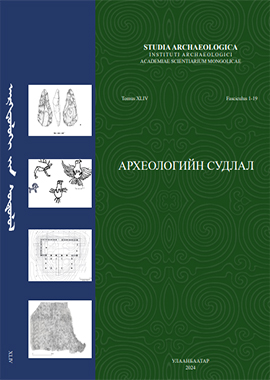Results of archaeological research of Kharkhul Khaan ruins (2022-2023)
DOI:
https://doi.org/10.5564/sa.v44i1.3529Keywords:
Middle Ages, Khanui River basin, Kharkhul Khaan ruins, ancient city ruinsAbstract
The ancient city of Kharkhul Khaan, situated in the expansive valley of the Khanui River beyond the Khangai Mountains, has garnered attention since the 1870s, as evidenced by references in the writings of foreign travelers and scientists. Subsequently, site garnered increased attention from national researchers starting in the 1950s. Excavations conducted by the “Kharkhorum” expedition during the 1980s and 1990s suggested multiple construction phases, one of which potentially overlapped with the city of Kharkhorum. Later research under the joint Mongolian-German project “Geomagnetic and pedestrian survey of Khar Khul Khan Balgas” (2017-2019) unearthed approximately 40 kilns used in the production of construction materials, shedding light on the city’s infrastructure. In 2022, the Institute of Archaeology, aided by the Ministry of Education and Science, conducted excavations along the central avenue of the city. These excavations yielded artifacts and construction materials closely resembling the architectural style and structure prevalent in urban settlements dating back to the 13th and 14th centuries in Mongolia and the surrounding region. Continuing into 2023, the Institute of Archaeology persisted in their excavations under the auspices of the Ministry of Education and Science’s major research initiative. During this period, they uncovered the remains of a grand Buddhist stupa-shaped temple in the northern sector of the city. Remarkably, the temple’s roof tiles bore depictions of deities, further accentuating its significance. Geomagnetic surveys delineated the city’s layout, revealing a well-planned urban center with intersecting boulevards and numerous structures. In 2022, excavations along the central avenue yielded artifacts and construction materials dating to the 13th-14th centuries, showcasing architectural similarities with urban sites in Mongolia and the wider region. Continuing in 2023, further excavations revealed the remains of a grand Buddhist stupa-shaped temple in the northern part of the city, adorned with roof tiles depicting deities, suggesting its significance as a majestic palace. The city’s overall layout, including the positioning of the Buddhist temple and aristocratic residences, bears resemblance to the urban planning of Kharkhorum, the capital of the Mongolian Empire, underscoring its scholarly importance. Scholars have affirmed the grandeur of the discovered structure, identifying it as a magnificent palace. The broader urban layout of the ancient Kharkhul Khaan city ruins holds significant academic value, particularly concerning the positioning of key landmarks such as the Buddhist temple, the central district, and the noble residences. This layout bears striking resemblance to the urban planning principles observed in the capital city of the Mongolian Empire, Kharkhorum, further enhancing its scholarly significance.
Хархул хааны балгасын археологийн судалгааны үр дүн (2022-2023 он)
Товчлол. Хангай нурууны ар бие Хануй голын уужим хөндийд төвхнөн суурьшиж асан Хархул хааны балгас хэмээх эртний томоохон хотын туурийг 1870-аад оноос гадаадын аялагч, судлаачид тэмдэглэлдээ дурдаж, 1950- иад оноос үндэсний судлаачдын анхаарлыг татаж, 1980-1990 онд “Хархорум” шинжилгээний анги малтлага явуулж, гурваас доошгүй цаг үед бүтээгдсэн болохыг тодорхойлон, тэдгээрийн нэг нь Хархорум хотын зарим барилга байгууламжтай нэгэн үед холбогдоно хэмээн үзсэн байдаг. 2017-2019 онд Монгол-Германы хамтарсан “Хархул хааны балгасын геомагнетик болон археологийн хайгуул судалгаа” төслийн хүрээнд Хануй голын савд хайгуул судалгаа гүйцэтгэж барилгын материал үйлдвэрлэж байсан 40 орчим зуухыг шинээр илрүүлэн, малтлага судалгаагаар бүтэц, зохион байгуулалтыг тодорхойлсон юм. Геомагнетикийн судалгаагаар Хархул хааны балгасын бүсийн дэвсгэр зургийг үйлдэж, огтлолцсон өргөн чөлөө бүхий олон барилга, байгууламжтай, төлөвлөлтийн дагуу байгуулсан томоохон хот байсныг баталгаажуулав. 2022 онд Археологийн хүрээлэн нь БШУЯ-ны дэмжлэгээр хотын төв өргөн чөлөөний хэсэгт малтлага судалгааг гүйцэтгэж, илэрсэн олдвор, барилгын материалууд нь Монгол болон бүс нутгаас илэрсэн XIII-XIV зууны үеийн хот суурины олдвортой хамгийн ойр хийц, бүтэцтэй болохыг тогтоосон юм. 2023 онд Археологийн хүрээлэн нь БШУЯ-ны судалгааны суурь санхүүжилтийн хүрээнд малтлага судалгааг үргэлжлүүлж хотын хойд хэсгээс бурхны дүртэй нүүр ваар бүхий буддын шашны томоохон суварга хэлбэрийн сүмийн туурийг илрүүлж, хотын баруун хэсэгт орших шороон хэрэм дотор орших барилгуудыг хаад язгууртанд зориулан луун хээтэй нүүр ваараар чимэглэн барьсан гоёмсог ордон байсныг тогтоогоод байна. Хархул хааны балгас эртний хотын ерөнхий төлөвлөлт, ялангуяа бурхан шашны сүм дуган, хотын төв хэсэг, хаад язгууртны орд барилгын байршил зэрэг нь Их Монгол Улсын нийслэл Хархорум хотын ерөнхий төлөвлөлттэй давхцаж буйгаараа эрдэм шинжилгээний хувьд онцгой ач холбогдолтой байна.
Түлхүүр үг. Дундад зуун, Хануй голын сав, Хархул хааны балгас, эртний хотын туурь
Downloads
363
Downloads
Published
How to Cite
Issue
Section
License
Copyright (c) 2024 Erdene-Ochir Nasan-Ochir, Ankhbayar Batsuuri, Batbold Gonchigsuren, Tsenguun Ganbold, Lkhagvasuren Bazargur, Nandintsetseg Narmandakh, Tuvshin Erdenebileg, Mart Batsaikhan, Ganbaatar Laikhan, Nyamkhuu Myanganbuu

This work is licensed under a Creative Commons Attribution-NonCommercial 4.0 International License.
Copyright on any research article in the Studia archeologica is retained by the author(s).
The authors grant the Studia archeologica license to publish the article and identify itself as the original publisher.
![]()
Articles in the Studia archeologica are Open Access articles published under a Creative Commons Attribution-NonCommercial 4.0 International License - CC BY NC.
This license permits use, distribution and reproduction in any medium, provided the original work is properly cited.




